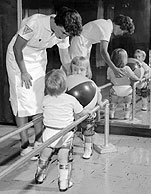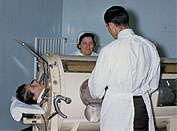 | Public-Health Victory: Vaccine-Related Polio Wiped Out in US |
 | Public-Health Victory: Vaccine-Related Polio Wiped Out in US |

A Brief HistoryNowadays, people in the US rarely think of polio, an infectious disease caused by a virus. Just 50 years ago, however, the virus was a real threat to children (mainly under the age of 5), causing thousands of children to become paralyzed. Many people died from polio. Children with paralyzed legs used wheelchairs, braces or crutches to get around. Parents would not allow their children to swim in natural swimming holes or rock quarries out of fear that the polio virus might lurk there. A real sense of panic set in every summer, when the number of cases rose sharply in the US (and Western Europe). Huge mechanical contraptions called iron lungs were used to assist breathing in those whose paralysis involved the torso. There is no cure for polio, making prevention the key in beating this highly infectious virus.
Vaccine DevelopmentIn the mid-1950s, Dr. Jonas Salk developed an injectable polio vaccine (IPV) from the inactivated (killed) virus. A few years later, Dr. Albert Sabin developed an oral polio vaccine (OPV) from a "live" virus. This became the vaccine of choice worldwide because it is less expensive, easier to give (no needle or trained
health caregiver needed) and rapidly stops the spread of
polio. The only disadvantage is that in rare cases, perhaps 1 out of every
2.5 million doses, the vaccine gives the recipient polio.
expensive, easier to give (no needle or trained
health caregiver needed) and rapidly stops the spread of
polio. The only disadvantage is that in rare cases, perhaps 1 out of every
2.5 million doses, the vaccine gives the recipient polio.
Polio: Defeated in the USAs a result of this vaccine-induced polio, in 2000 the US government stopped using the "live" virus vaccine. Since using IVP, the last US case of vaccine-related polio was documented in 1999, according to a study published in the Journal of the American Medical Association.A Global PerspectiveMore work worldwide is still needed to stamp out polio completely. The goal of the Global Polio Eradication Initiative, a joint effort by the WHO, Rotary International, the US Centers for Disease Control (CDC) and UNICEF, is to have zero new cases of polio by 2005. Since 1988, when the Initiative started, the number of polio cases worldwide has dropped 99%.
The Numbers Tell A Tale of ProgressAs recently as 1988, more than 125 countries on five continents were home to the polio virus, resulting in more than 1,000 children per day becoming paralyzed. In 1988, there were 350,000 cases worldwide; by 2002, thanks to vaccination efforts, the worldwide count was down to around 1900 cases.
Future WorkPolio is still a threat to children in seven countries in sub-Saharan Africa and south Asia. As of November 24, 2004, there were a total of 683 cases in Nigeria, 91 in India, 40 in Pakistan and 21 in Niger. There were a few cases in Afghanistan and Egypt.Image credit: CDC |
| Did You Know?
POLIO |
|

|
Interview a parent or grandparent (or an older friend or neighbor) and ask about their memories of polio. |
|
References and Further Information:
|
| GO TO: | Explore the Nervous System | Table of Contents |
![[email]](./gif/menue.gif) Send E-mail |
 Get Newsletter |
 Search Pages |
This article prepared by Ellen Kuwana, Neuroscience for Kids Staff
Writer.
Last updated: June 10, 2005